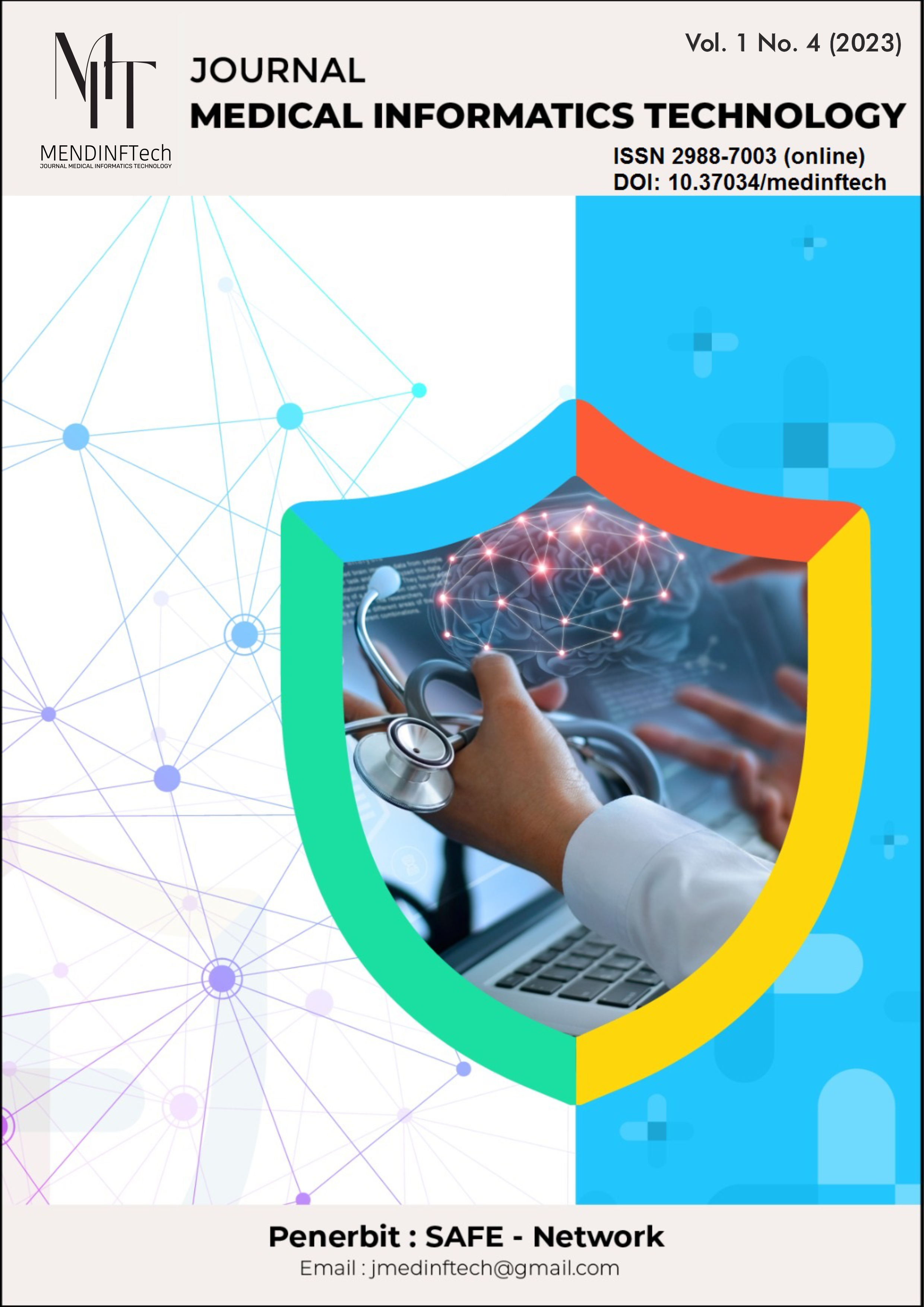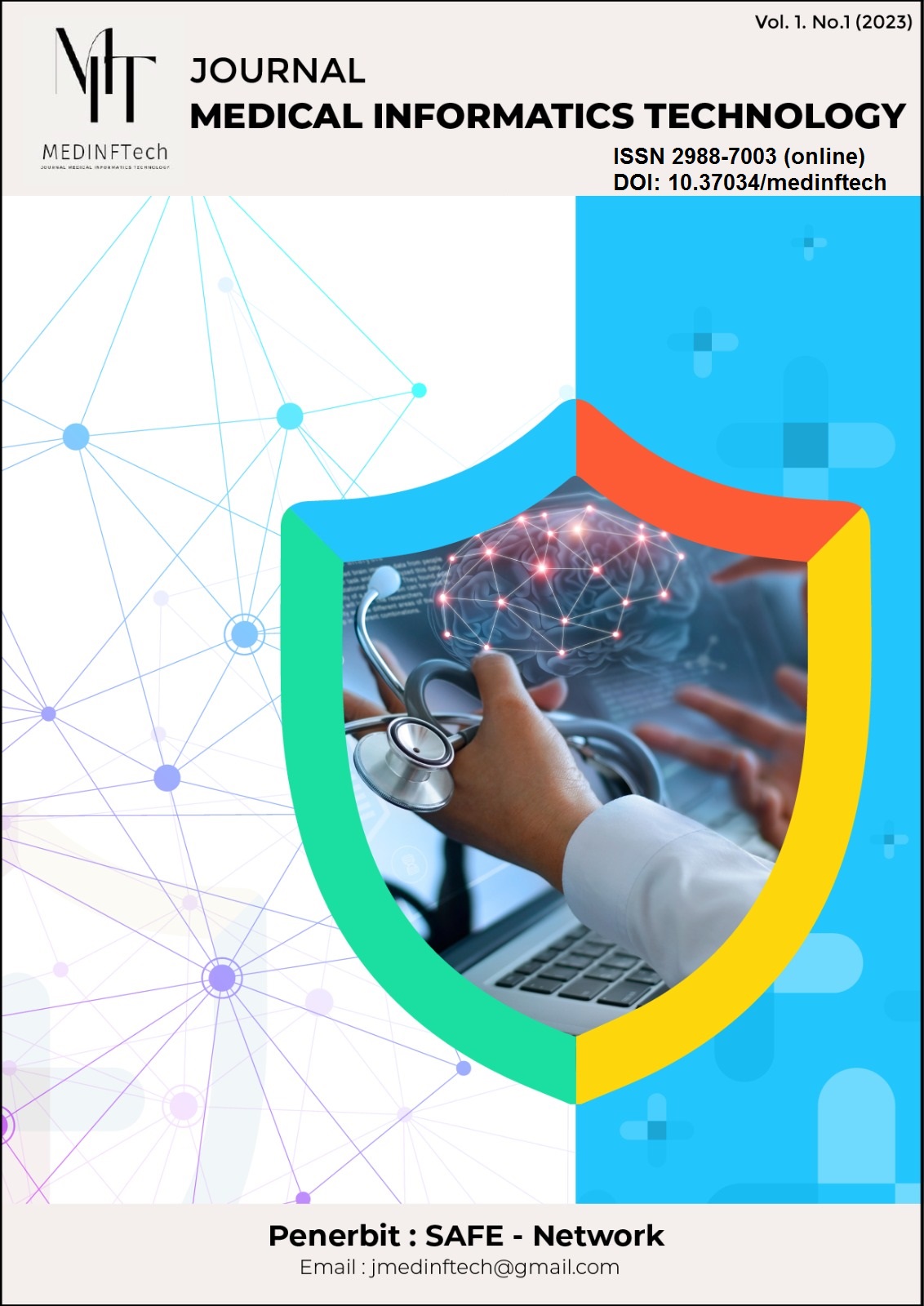Relevance of e-Health Needs and Usage in Indonesia
DOI:
https://doi.org/10.37034/medinftech.v1i4.20Keywords:
e-Health, Implementation, User Survey, Utilization, RelevanceAbstract
The eHealth application can be used for healthcare, supervision, literature, education, and research. It is a cost-efficient and secure application based on information and communication technology for the health and medical fields. The use of Information and Communication Technology (ICT) as an infrastructure or medium that connects hospitals and health centers using the eHealth electronic health application is the key problem facing the implementation of eHealth on a worldwide scale. eHealth is an ICT-based application for the healthcare industry and one of the Action Plans of the World Summit on the Information Society (WSIS) Geneva 2003. The goal of using the eHealth app is to increase patient access, medical process efficiency, effectiveness, and process quality. This covers the administration of medical services provided by hospitals, clinics, health centers, medical professionals (including therapists and doctors), laboratories, pharmacies, and insurance
Downloads
References
M. Misnaniarti, “Ketersediaan Fasilitas dan Tenaga Kesehatan Dalam Mendukung Cakupan Semesta Jaminan Kesehatan Nasional”, jpppk, vol. 1, no. 1, pp. 6-16, Sep. 2018.
M. A. Ag Ahmed, M.-P. Gagnon, L. Hamelin-Brabant, G. I. Mbemba, and H. Alami, “A mixed methods systematic review of success factors of mhealth and telehealth for maternal health in Sub-Saharan africa,” mHealth, vol. 3, pp. 22–22, 2017. doi:10.21037/mhealth.2017.05.04.
S. Petter, W. DeLone, and E. R. McLean, “Information Systems Success: The quest for the independent variables,” Journal of Management Information Systems, vol. 29, no. 4, pp. 7–62, 2013. doi:10.2753/mis0742-1222290401.
D. L. Goodhue and R. L. Thompson, Task-technology fit and individual performance - JSTOR, https://www.jstor.org/stable/249689 (accessed Nov. 10, 2023).
T. Mettler, “Anticipating mismatches of hit investments: Developing a viability-fit model for e-health services,” International Journal of Medical Informatics, vol. 85, no. 1, pp. 104–115, 2016. doi:10.1016/j.ijmedinf.2015.10.002.
M. A. Zayyad and M. Toycan, “Factors affecting sustainable adoption of e-health technology in developing countries: An exploratory survey of Nigerian hospitals from the perspective of healthcare professionals,” PeerJ, vol. 6, 2018. doi:10.7717/peerj.4436.
V. M. Kiberu, M. Mars, and R. E. Scott, “Barriers and opportunities to implementation of sustainable e-health programmes in Uganda: A literature review,” African Journal of Primary Health Care & Family Medicine, vol. 9, no. 1, 2017. doi:10.4102/phcfm.v9i1.1277.
A. Omotosho, P. Ayegba, J. Emuoyibofarhe, and C. Meinel, “Current state of ICT in healthcare delivery in developing countries,” International Journal of Online and Biomedical Engineering (iJOE), vol. 15, no. 08, p. 91, 2019. doi:10.3991/ijoe.v15i08.10294.
G. B. Fanta and L. Pretorius, “A conceptual framework for sustainable ehealth implementation in resource-constrained settings,” South African Journal of Industrial Engineering, vol. 29, no. 3, 2018. doi:10.7166/29-3-2055.
M. R. Hoque, Y. Bao, and G. Sorwar, “Investigating factors influencing the adoption of e-health in developing countries: A patient’s perspective,” Informatics for Health and Social Care, vol. 42, no. 1, pp. 1–17, 2016. doi:10.3109/17538157.2015.1075541.
E. K. Adu, N. Todorova, and A. Mills, “Do individuals in developing countries care about personal health information privacy? an empirical investigation,” AIS Electronic Library (AISeL), https://aisel.aisnet.org/confirm2019/16 (accessed Nov. 10, 2023).
W. Wilkowska and M. Ziefle, “Privacy and data security in E-health: Requirements from the user’s perspective,” Health Informatics Journal, vol. 18, no. 3, pp. 191–201, 2012. doi:10.1177/1460458212442933.
P. K. Sari, P. W. Handayani, and A. N. Hidayanto, “Security value issues on eHealth implementation in Indonesia,” IOP Conference Series: Materials Science and Engineering, vol. 879, no. 1, p. 012040, 2020. doi:10.1088/1757-899x/879/1/012040.
[1] S. Rosadi, “Implikasi PENERAPAN program E-HEALTH dihubungkan dengan perlindungan Data pribadi,” Arena Hukum, vol. 9, no. 3, pp. 403–420, 2016. doi:10.21776/ub.arenahukum.2016.00903.6.
F. D. Davis, “Perceived usefulness, perceived ease of use, and user acceptance of Information Technology,” MIS Quarterly, vol. 13, no. 3, p. 319, 1989. doi:10.2307/249008.
“Global diffusion of ehealth: Making universal health coverage achievable,” Google Buku, World Health Organization books.google.com (accessed Nov. 10, 2023).
C. B. Aranda-Jan, N. Mohutsiwa-Dibe, and S. Loukanova, “Systematic review on what works, what does not work and why of implementation of mobile health (mhealth) projects in Africa,” BMC Public Health, vol. 14, no. 1, 2014. doi:10.1186/1471-2458-14-188.
M. Rezai-Rad, R. Vaezi, and F. Nattagh, “E-health Readiness Assessment Framework in Iran,” Iranian journal of public health,https://www.ncbi.nlm.nih.gov/pmc/articles/PMC3494230/ (accessed Nov. 10, 2023).
N. Archer, C. Lokker, M. Ghasemaghaei, and D. DiLiberto, “EHealth implementation issues in low-resource countries: Model, survey, and analysis of User Experience,” Journal of Medical Internet Research, vol. 23, no. 6, 2021. doi:10.2196/23715.









